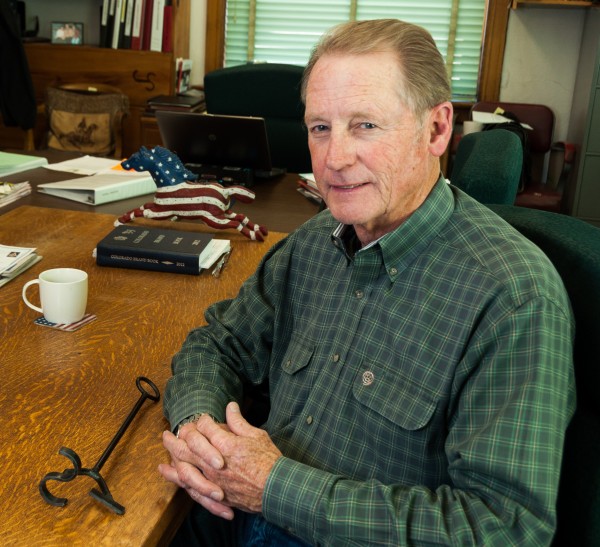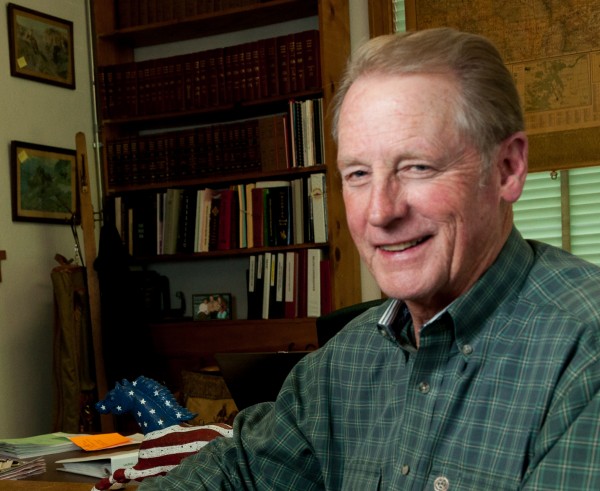Brands. The return address for 3 million livestock in Colorado.

Chris Whitney grabbed a pair of worn leather gloves from his back pocket, pulled them on with his teeth and stoked the campfire and the red-hot branding irons which read Lazy T Reverse F.
The young calves were restless and noisy. Whitney looked across the Uncompaghre Valley at the towering snow-capped peaks of the Cimarrons and San Juans. It would be his last spring roundup at his family’s ranch in Ridgway, Colorado, before he left for college at the University of Colorado.
Armed with a master’s degree, and a commission as an Air Force lieutenant, he was assigned, in 1968, to an intelligence unit in Vietnam (6499th Special Activities Group, based in NhaTrang).
After the Air Force, he spent the next 35 years as an attorney in private practice in Washington, D.C. and Colorado, and served as an in-house litigation and general counsel to several large public companies.
The memories of life in the mountain valley lingered with Whitney. He returned to Colorado in 1996 and renewed acquaintances with the cattle industry, eventually being selected to serve on the State Board of Stock Inspection. In 2011, he was appointed Brand Commissioner.
Like thousands of people in Colorado, Whitney owns a registered brand but has never used it on cattle or horses. About half of the more than 35,000 brands on file at the Brand Board are not used on livestock but designed and registered by citizens for their own enjoyment. The 4,000-year-old custom of creating brands is a necessity for livestock owners and remains valued by people who just want a brand of their own. His brand reads Bar 2D.
WHITNEY
I created the brand in honor of my two daughters. Every five years I pay my assessment to keep the brand. It comes to you as a deed. It passes like real property. You can buy or sell it or leave it to an estate. Brands have been a part of Colorado’s history in one form or another since 1865. The oldest brand we have on file was registered in 1899 to H.F. Dreyer of Brighton, Colorado.
We’ve had brands that have been transferred within families, bought and sold, so all the legal niceties that you can imagine go along with ownership — just like selling a car or real estate.
TRIBUTARY
That’s where your legal background comes in,
WHITNEY
It has been valuable, yes.
TRIBUTARY
Last year, according to your staff, the Brand Board’s 60 inspectors traveled 1.1 million miles, covering Colorado’s 104,000 square miles inspecting several million head of livestock and picking up almost 4,000 strays. And, the office staff registered more than 400 new brand applications. That’s a lot of work. How many livestock are in Colorado.
WHITNEY
We estimate about three million head of livestock. Our job is to verify ownership in order to protect Colorado’s $3 billion livestock industry from loss by theft or straying. This is by far the biggest piece of what we do. We like to say brands are livestock’s “return address”. Colorado is an open range state. Livestock have always been permitted to range wherever they want. If you don’t want them on your property, you have to fence them out. The livestock owners don’t have an obligation to fence them in. So now you can see why brands are important because you can have thousands of head of cattle wandering everywhere and no one can watch every single head. Brands have always been, and still are, the identifier of choice.
“Livestock” includes cattle, horses, mules, burros and sheep. Branding is not required in this state, but cattlemen tend to brand because their cattle roam. Horses don’t tend to wander as much and they are considerably less valuable than cattle. If you figure the “blended price” of cattle, from a calf all the way to a bull, is around $1,000 a head, that’s a lot of money walking around. You can’t give away horses in this day and age because there are too many around. So only about 50 percent of horse owners brand their horses. Almost all cattlemen brand their cattle.
TRIBUTARY
One of the reasons for the creation of the Colorado Cattlemen’s Association, a century ago, was to solve the problem of cattle rustling. They established the brand registration system.
It was put together by the cattlemen because they wanted a means of protecting their herds and their livelihoods. It is still 100 percent funded by the roughly 12,900 livestock producers. We don’t receive a nickel of state money. We are funded by the fees and assessments for the brands and brand inspections. We are responsible to the people who pay us which are the men and women in the livestock industry.
A round up and inspection tax was imposed by the young State of Colorado in 1879 and a three-member Board of Inspection Commissioners was created with the power to hire brand inspectors to inspect cattle at markets inside or outside of Colorado, and to inspect herds of cattle being shipped or driven out of the state.
I had one person ask me one time, “Well, don’t the cattlemen resent you guys out there conducting inspections?”
My response is: we’re with those guys. They want us to perform this service. We’re not the enemy; we’re their allies. That doesn’t mean we always see eye to eye on things. But they see value in what we do or they wouldn’t continue to fund us.
TRIBUTARY
Livestock theft in most western states is trending upward. Cattle rustlers haven’t disappeared have they?
WHITNEY
That is because the value of cattle is high and it’s worth the risk. The market for cattle is very strong and getting stronger because the total herd size is smaller. What you have is worth more. In this day and age, you can drive a truck into a pasture somewhere and quickly load some animals and be gone before anybody knows you were there.
TRIBUTARY
Where are they taken? To resale? Straight to slaughter?
WHITNEY
Generally what the thieves do is go across state lines to states that don’t have brand laws. We have very close working relationships with most of the western states, though. When we have missing cattle we talk to each other and we have a whole protocol about reporting to each other.
Last year, we inspected 4.3 million cattle, 34,167 horses, 1,157 sheep and issued 4,582 permanent travel permits on horses. We identified ownership of lost, stolen, strayed and questionably-owned livestock valued at over $24 million.
It is very tough for you to go straight to slaughter because you will be required to show brand papers upon arrival. If you take them to sale, the same is true. If you show up without papers, we’ll seize the animal. We may allow it to be sold, but we’ll hold the proceeds from the sale until you can demonstrate, through a brand inspection, or some other means satisfactory to us, that you are the owner.
We also license sale barns, certified feedlots and alternative livestock, which are captive domestic elk and fallow deer. We inspect them just like we inspect cattle.
TRIBUTARY
Has the method of branding changed to computer chips, ear tags, bar codes, that sort of thing?
WHITNEY
Hot iron branding is still the preferred method. That’s because most branding is still done outside and no one has a that long of an extension cord for an electric branding iron. Horse brands tend to be applied with a method called freeze branding.
TRIBUTARY
What about altering brands? Is that still attempted?
WHITNEY
Yes. Absolutely. Altering a brand is a felony. There are a plethora of statues that deal with livestock and branding. If you steal livestock for example, you face penalties under the livestock laws and felonies for theft under criminal laws. Theft is theft. That said, there are number of laws that are peculiar to branding and the livestock industry.
_________________________
The High Lonesome You can feel all alone in a city that’s big,Where people will walk all over someone
And not care a fig.
You see that, and your nerves come undone. You need to light out to the High Lonesome.
Come out to repair the rips in your psyche and soul.
Better that than to bury yourself in some city hole.
Come out to the High Lonesome, and be back in control. Look at the forest, and don’t miss the trees.
Smell the freshness in the mountain meadow breeze.
Spy a stag unawares drinking from a stream with no cares.
Wonder at the stars, and forget about putting on airs. You’re a part of all this grandeur, this vista, this view,
And remember, now and forever, it’s all part of you.
Whenever the city and civilization seem too much to take,
Remember the High Lonesome and take a wilderness break. — Paul Harwitz (2002)
____________________________
RELATED LINKS
Brands have language of their own.
Video tour of the Brand Board at the Livestock Exchange Building, Denver
Vintage Colorado Brand Books for sale
Round up your family history with livestock brands
SUPPORTING TRIBUTARY
- Word of mouth is our most reliable resource. Please let others know about Tributary and why you appreciate the effort.
- Please use the Share Your Thoughts section to add your thoughts on this story. We enjoy the conversation.
- And, use our Facebook page to give us a story idea. Share your comments too. Let your friends know about Tributary.
- Tell us your story privately, or suggest someone with an interesting story, via email at [email protected].
To be a person is to have a story to tell. – Isak Dinesen.

